If you’re a founder who knows that SEO matters, but doesn’t know where to start, check out this one-page primer.
Thanks to the following founders for sharing feedback on this guide:
- Juan Bello, Porter
- Liam Jones, Pilla
- Yanan He, stealth startup
- Aaron Beashel, Attribute
- Jaroslav Filak, ExpenseMonkey
Sidenote. I’m writing this based on my experience helping startups from pre-seed to post-IPO with their search strategy. I also taught some of these ideas as part of the a16z Marketing Counsel Series.
What SEO does
You already know that you need SEO, but it’s worth reiterating the benefits. SEO can help you:
- Show up when people search for your company name.
- Appear when people search for problems that your product can solve.
- Find the exact language people use to describe your product (and quantify the demand for it).
- Siphon users away from your competitors.
- Create predictable customer acquisition and reduce your customer acquisition costs.
- Build a moat of backlinks and brand awareness that makes it difficult for other companies to compete with you.
When to invest in SEO
Some startups use SEO as their primary acquisition channel from day one. For these companies, SEO only makes sense if you…
- Understand your target customer. Effective SEO depends on a basic understanding of your target customers’ problems and pain points. If you don’t have a handful of customers who are paying (and sticking around), it’s hard to make SEO work.
- Know how your customers buy. SEO is useful for many types of products, but not all—some buying processes happen almost entirely outside of organic search (not many seven-figure hotel flooring deals start from Google searches for “carpet for high-traffic areas”).
- Can afford to commit for the long term. SEO is a long-term play, requiring months to years of sustained effort to get best-in-class results.
For most companies, SEO is a channel for scaling growth, not achieving product/market fit. It’s a way to add fuel to your fire, not start the fire.
It makes sense to invest more heavily in SEO when you want to…
- Diversify your acquisition channels. Most startups invest in SEO when outbound or paid advertising is starting to get expensive and generate diminishing returns.
- Reduce CAC. It’s one of the only truly compounding growth channels: money spent today on SEO can generate better and better returns in the future, as your pages rank and generate traffic for years to come. This is particularly crucial for freemium business as it helps offset the negative effect of churn rates.
- Make life harder for your competitors. SEO is increasingly zero-sum: a handful of brands get most of the clicks for a given keyword. It’s good for you to be one of those brands, and bad for your competitors.
How SEO works
There are three pillars of SEO:
- Content: the pages you create, including articles, tools, and landing pages.
- Links: backlinks from other websites back to yours.
- Technical: ensuring that there are no technical problems limiting your ability to appear in search engines.
They all matter, but to get started, I recommend prioritizing like this:
1. Content
Content matters the most. The more search-optimized content you create, the more chances you create for Google to show your company to relevant people. Content is both your biggest growth lever and your greatest bottleneck.
Great content can earn great links, almost passively. Inversely, it’s very hard to earn links without great content. Content can help explain the benefits of your product, and nudge people towards a purchase. Every new content page you create provides another “doorway” from the wilds of the internet into your website.
Further reading
- SEO Content: The Beginner’s Guide
2. Links
Links play a big role in SEO. Google and other search engines use links as a vouch of confidence for your site (Google’s system is known as PageRank). Sites with more, higher-quality links, generally rank better in search.
As a general rule, links that are easy to get (like adding your website to a free startup directory) will have less of an impact than links that are difficult to get (like a relevant product mention in a well-respected industry blog).
There are exceptions to these rules, but generally speaking, you want to build links:
- On websites which are relevant to your business
- With descriptive anchor text (your brand name or company description, not “click here”)
- That are dofollow
Further reading
- Link Building for SEO: The Beginner’s Guide
3. Technical
No amount of content or links will help if Google’s crawlers can’t visit your pages or your website is hidden from search.
For most new or small websites, technical SEO is not a problem. Most popular CMSs (like WordPress, Wix, or Webflow) have decent technical SEO out of the box. This might not be the case if you’re running a custom CMS and compiling a bunch of static pages.
Think of technical SEO as removing barriers to good search performance. Technical problems can hinder your SEO, but good technical SEO alone isn’t enough for your website to actively grow its search presence.
Further reading
- The Beginner’s Guide to Technical SEO
How to start SEO
Here are some straightforward starting points for your SEO strategy:
1. Fix obvious technical SEO problems
Before you spend time or money on content creation or link building, make sure your technical SEO is sound. You can check for most common technical SEO problems with a free AWT account.
Here are some of the technical SEO issues on the Ahrefs blog. They’re prioritized by likely importance: blue items are notices, yellow items are warnings, and red items are errors:
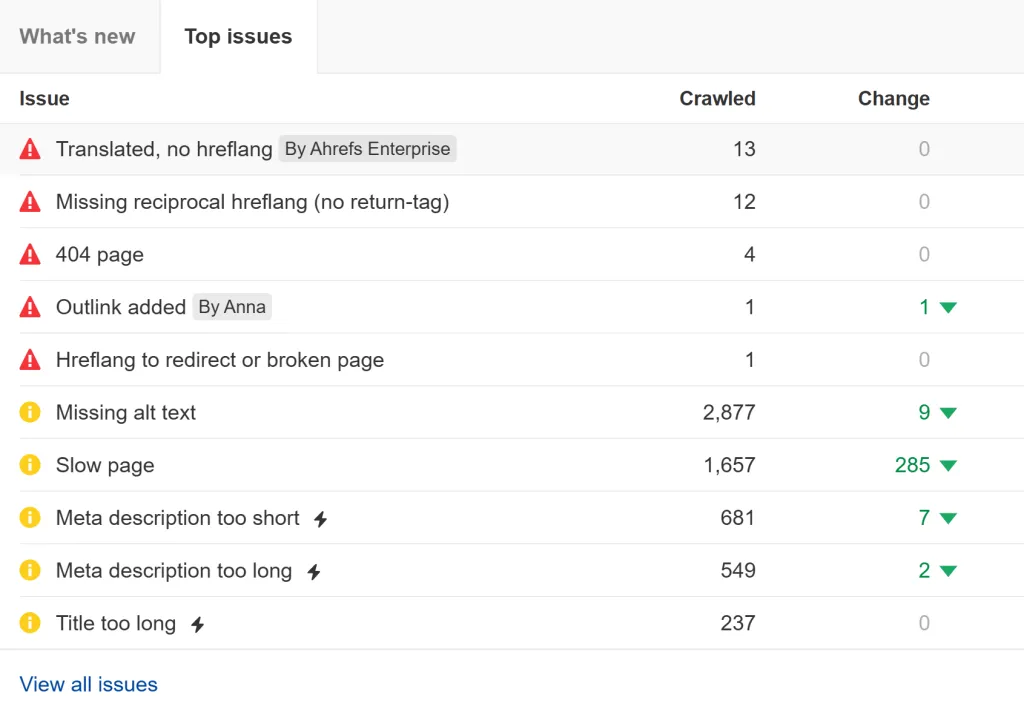
As a priority, make sure your website is accessible to crawlers and your pages are allowed to be indexed by Google.
Further reading
- We Studied Over 1 Million Domains to Find the Most Common Technical SEO Issues
2. Get your first few links from your network.
In the early days of SEO, earning a few relevant backlinks can make a huge improvement to SEO performance.
Link-building often feels like it’s outside your locus of control, but there are plenty of ways to predictably build good links. In the long term, creating content will make it easier to acquire backlinks. In the short term, you can use your network to get started:
- Get listed on your investors’ portfolio pages
- Ask integration partners to link to your website
- Launch on Product Hunt
- Appear on podcasts
- Ask other founder friends if you can contribute to their blog
In the beginning, it’s a good idea to prioritise relevant links; over time, you can consider extra factors like domain rating.
Further reading
- How to Get your First 100 Backlinks
3. Find your competitor’s best pages (and copy them)
Start making content by finding the pages that are driving the most organic traffic for your competitors, and creating your own (better) versions.
You can find these pages in Ahrefs using the Top Pages report. Here’s a list of Ramp’s most popular blog articles, ordered by estimated organic traffic:
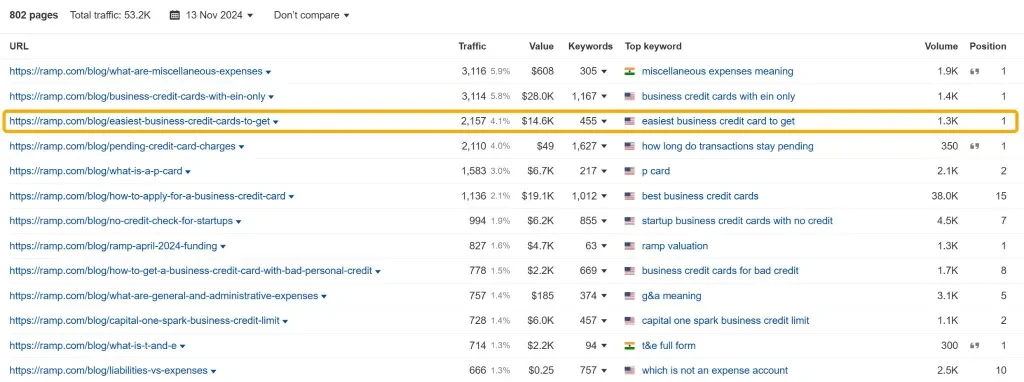
If I competed with Ramp, I would consider publishing my own articles targeting some of these keywords—like this guide to the easiest business credit cards to get, generating an esteemed 2,157 visits from organic search each month.
You can also see any website’s most linked-to pages using the Best by links report. Here, Ramp’s guide about how to apply for a business credit card has earned 211 backlinks from 99 different websites:
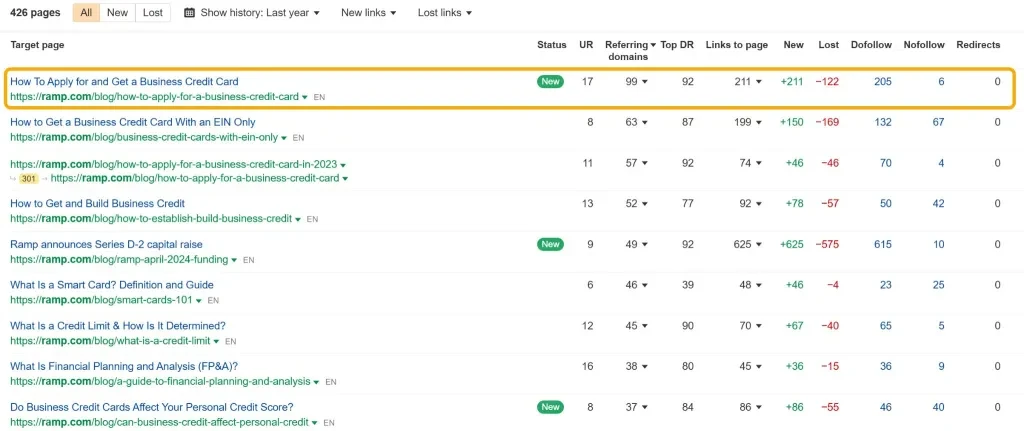
If we created a similar guide, there’s a good likelihood we could earn links with it too.
The importance of ‘business potential’
Many companies try to rank for keywords that have lots of potential traffic but very little relevance to their product. Instead, it’s better to write about problems your product can solve. That way, every visitor is a potential customer.
You can use the “Business potential” framework to help evaluate each topic. Score each keyword, and prioritize those with a high business potential:
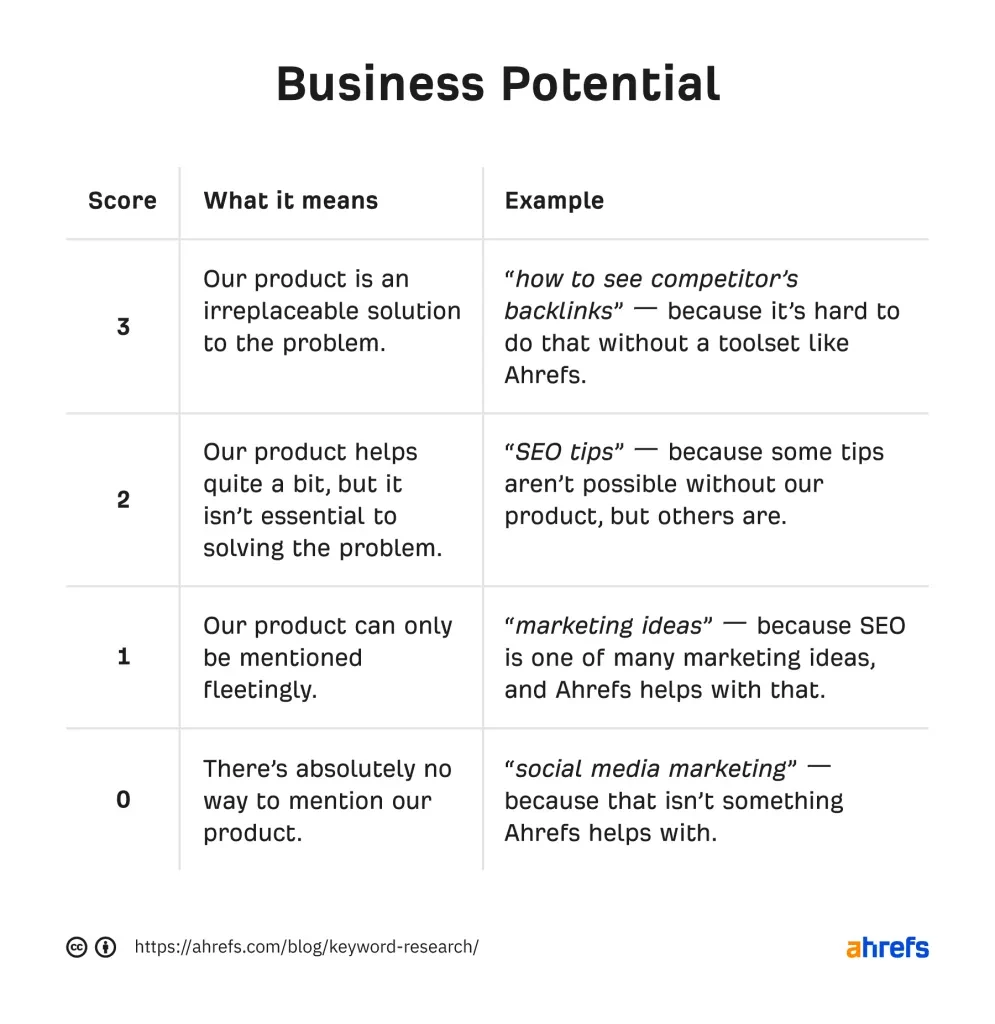
The goal of SEO is not just to chase high keyword volumes and amass backlinks, but to attract people that have a substantial chance of becoming a customer.
4. Find questions your target audience asks (and answer them)
Your potential customers probably have thousands of questions about your product and your industry. By identifying the most popular of these questions—and then writing helpful answers—you can create a steady stream of relevant people visiting your website.
Start by thinking up a few “seed” keywords: core topics that relate very strongly to your product.
For a company like Ramp, that might be “business credit cards”. In our Keywords Explorer tool, you can use AI to help with this brainstorming process:
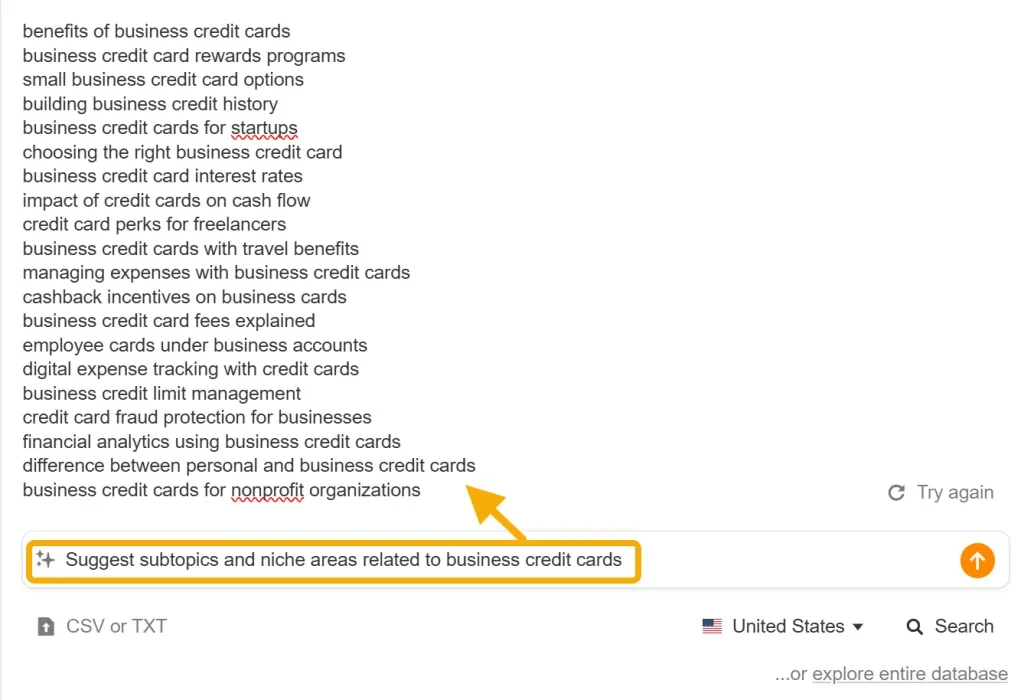
Hit “search”, and you’ll be able to see the estimated number of searches each keyword gets¹, and an estimate of how difficult it will be to successfully rank for the topic² (along with a bunch of extra data points):
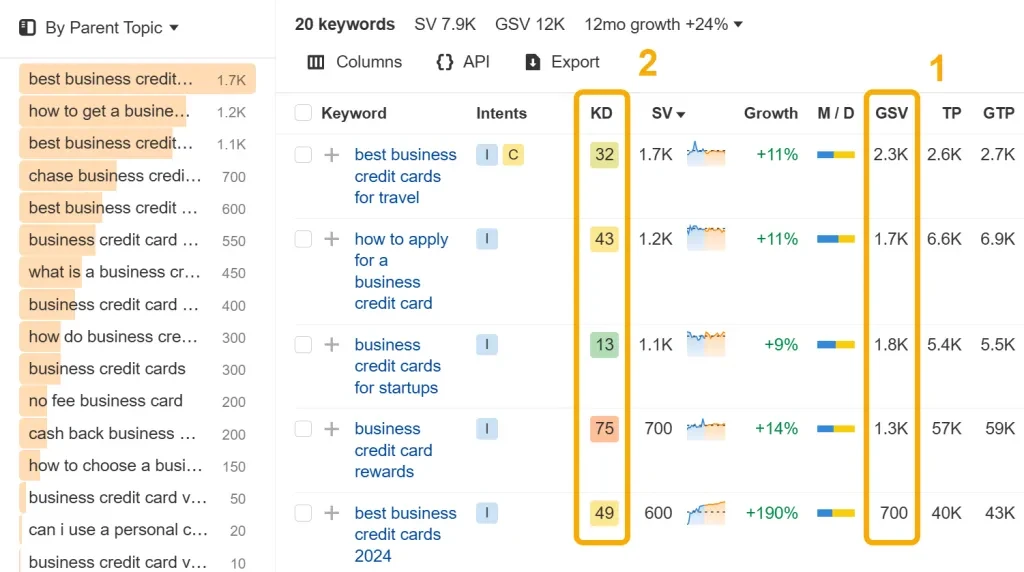
You can expand your list of topics using the Matching terms, Related terms, and Search suggestions reports to show hundreds of related keywords:
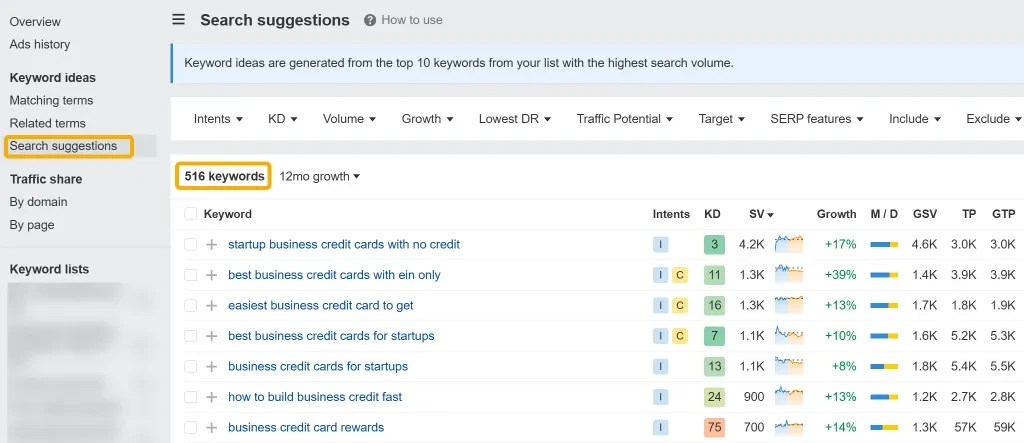
If your website is relatively new, you’ll struggle to rank for high-competition keywords. It’s better to start by targeting low-difficulty keywords and gradually working towards more competitive ones as you earn more backlinks and generate more organic traffic.
You can find these keywords in Ahrefs by filtering to show keywords with a low difficulty (say, up to 30):

Further reading
- How to Do Keyword Research for SEO
5. Create integration pages and competitor comparison pages
Most startups are competing against established companies. Creating pages that draw direct comparison between your product and these competitors can be a great SEO strategy, allowing you to capture existing demand for products like yours, instead of trying to create demand from scratch.
Here’s a list of Podia’s competitor comparison pages. Their comparison with Stan Store generates an estimated 3,444 organic visits to their website each month:

These pages are worth creating even if you don’t have feature parity with your competitors. It’s an opportunity to explain your differences, the thought process behind your product decisions, and begin the long-term process of positioning yourself as a meaningful competitor to the industry giants.
If your product is part of a bigger software ecosystem—if you’re a Shopify app, or you integrate with Google Looker Studio—you can also build landing pages for each of your integration partners. These allow you to capture a small-portion of the existing demand for the big, popular products you integrate with.
Here’s Ahrefs data for the keyword google looker studio connectors: low difficulty, a hundred searches per month, and highly relevant for products that integrate with Looker:

6. Get creative
When you’re starting SEO, the fastest, most direct route to revenue is to take inspiration from the tried-and-tested topics that already make money for your competitors. But in the long term, there’s a real benefit to doing things that other companies haven’t tried yet.
SEO is a creative process. With a bit of research, you can probably find significant alpha for yourself: topics your competitors haven’t covered, pain points that no one solves, integrations in high demand, or even burgeoning keywords that are about to become very popular.
The perennial startup advice applies here too: talk to your customers. Learn about their problems and questions, brainstorm new topics to cover, and use a tool like Ahrefs to help vet whether those ideas are worth your time.
How to scale SEO
Longer-term, most companies with serious SEO traffic acquire it in one of four ways:
1. Editorial content: long-term, educational blogging
Editorial content refers to the process of publishing high-quality, educational resources targeted at relevant keywords. By systematizing content creation and publishing SEO content every week, many companies generate hundreds of thousands of monthly visits from blogging alone.
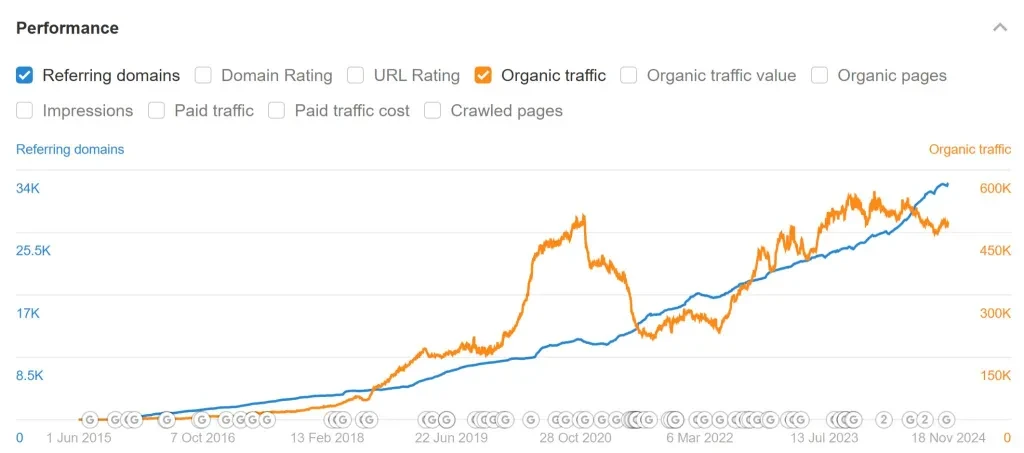
Editorial content is great for building brand awareness and educating visitors, but—even in the era of ChatGPT—it’s an expensive strategy.
Blogging is also very competitive today. Most high-volume keywords are already contested by big, well-known brands (with even bigger budgets). There are plenty of opportunities to become one of these brands, but it’s harder than ever before.
Check out these examples of editorial content:
- The Ahrefs blog
- The Intercom blog
- The Ramp blog
- The Buffer blog
2. Programmatic content: semi-automated landing page creation
Programmatic content describes the creation of keyword-targeted pages in an automatic (or near automatic) way.
It provides a way for companies to create thousands of website pages targeted at thousands of keywords—without having to design, write, and publish pages manually. Programmatic pages are usually created from data like product prices, weather, or location information. Companies like Zapier, Zillow, and G2 use programmatic SEO to generate millions of pageviews each year.
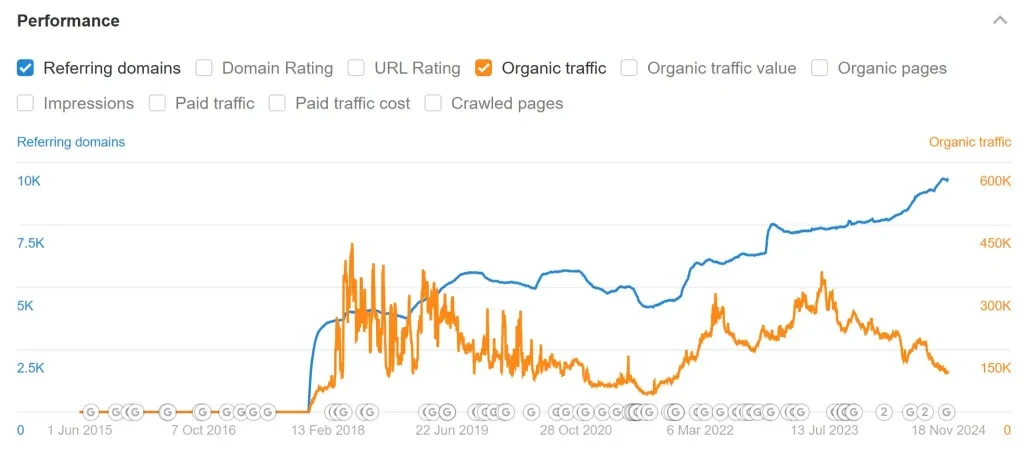
This strategy often appeals to technical founders, but it’s not without risk. Programmatic content that is deemed thin or spammy will struggle to rank, or may even be dropped from search. For this reason, it’s a great counterpart to a “safer” SEO strategy, like editorial content or free tools. Put another way: only consider programmatic SEO if you can afford to lose all of the traffic it creates.
Check out these examples of programmatic content:
- Zapier’s app directory
- Wise’s currency conversion pages
- Ahrefs’ top websites list
Further reading
- Programmatic SEO, Explained for Beginners
3. UGC: curating content created by your users
User-generated content is the process of curating and search-optimizing content created by your users: like product templates, portfolios, or even articles.
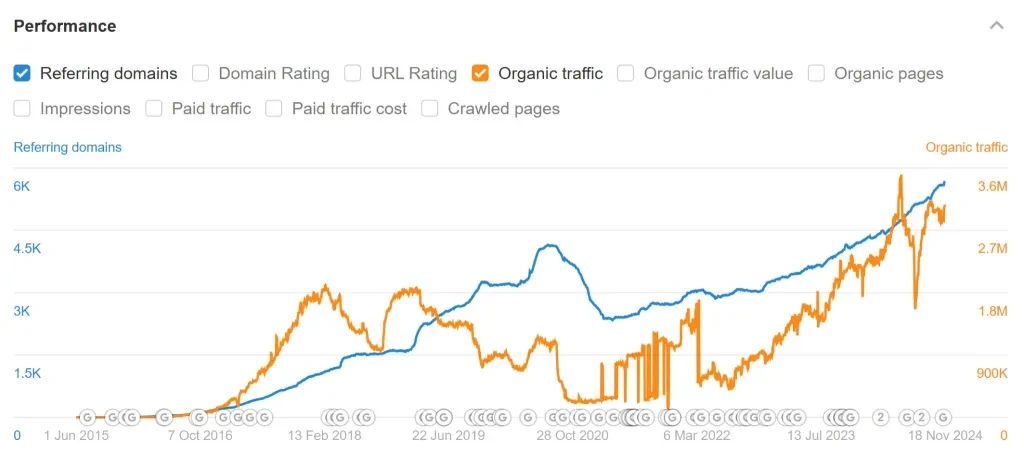
UGC allows you to outsource the effort of content creation, allowing you to generate potentially millions of pages of content with relatively little cost. But UGC also runs the risk of abuse (like your content being highjacked by spammers—see this example from Contently) and high moderation costs.
Check out these examples:
- Canva’s design templates
- Reforge’s product marketing artifacts
- Webflow’s website templates
- Perplexity’s user-curated articles
4. Free tools: free versions of your product functionality
Free tools involve offering a simplified version of your product, or tools tailored to solving specific problems.
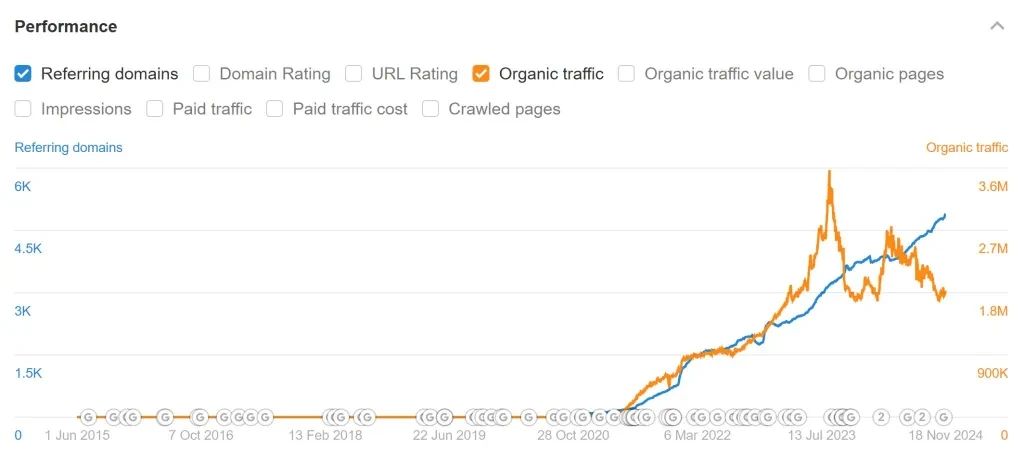
There are many high-traffic keywords that can only be targeted using free tools. Here’s the search results page for “free backlink checker”. The first 19 results are all free tools, without an article in sight:
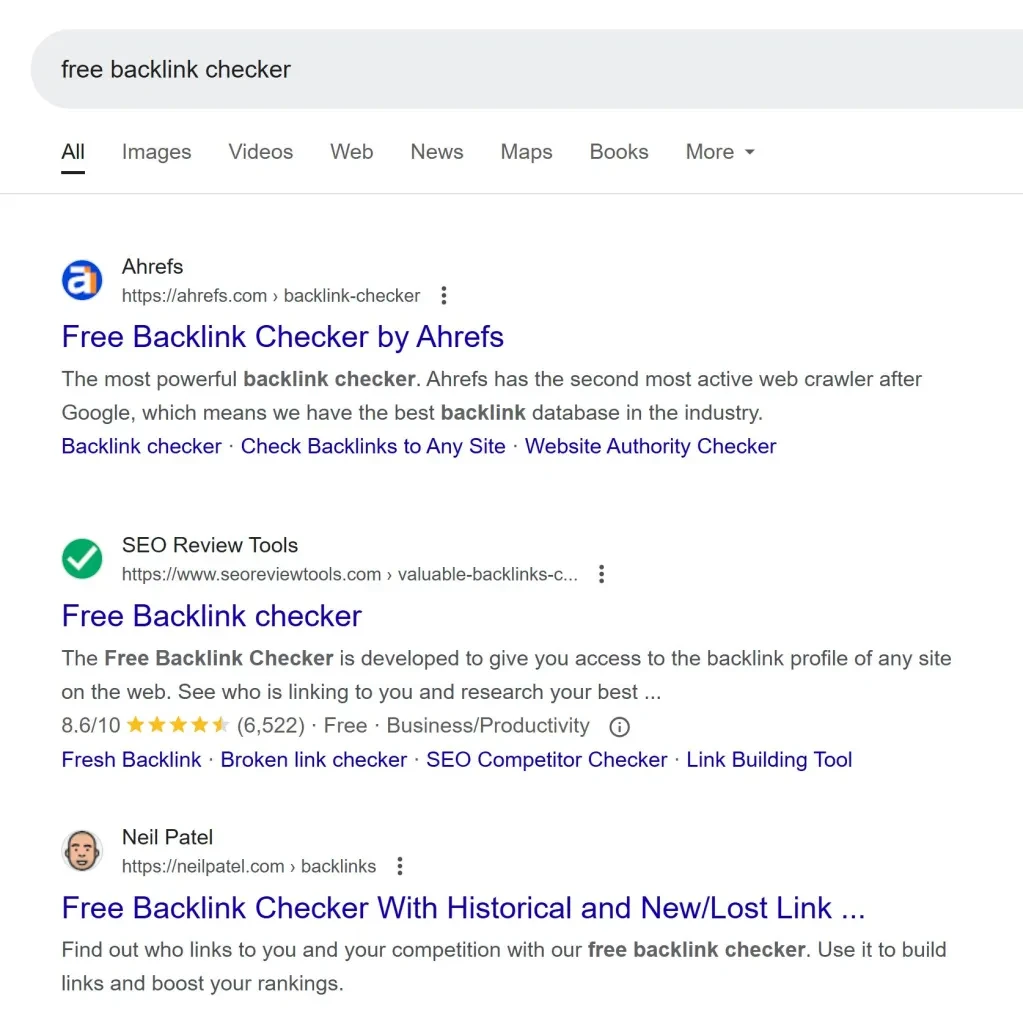
Free tools can provide a good opportunity to naturally introduce your paid product to free users. The added complexity of creating these tools also means that this strategy is harder for your competitors to immediately copy.
As an obvious downside, these tools take development resources to build and can generate sizeable operating costs.
See these examples of free tool strategies:
- VEED’s free video editing tools
- Ahrefs’ free SEO tools
- Shopify’s free small business tools
FAQs
Is SEO dying?
SEO isn’t dying, but it is changing. ChatGPT Search, Perplexity, and other LLMs offer an alternate way for users to access information online. AI Overviews have the potential to reduce the number of people visiting websites from search results. AI-generated content is increasing the competition in many search results.
The best practices of SEO remain the same, but it’s worth exploring topics like LLM optimization and learning about AI Overviews.
How should I make content?
There are four main ways to create, each with pros and cons:
- In-house: Creating content yourself offers the greatest control over quality, but necessitates a ton of time and knowledge to create.
- Freelancers: Relatively affordable but require lots of sourcing writers, management, quality control, and editing.
- Agencies: Offer a done-for-you service that often benefits from experience working across dozens of similar companies, but can be very expensive.
- AI content generation: Extremely cheap to create but still requires marketing and SEO expertise to get good results. Publishing bad AI content can have a negative impact on your SEO.
Should we hire an SEO agency?
A great SEO agency can have a huge positive impact on your growth. The hard part is finding the great ones. I’ve had positive experiences with the following agencies: Organic Growth Marketing, Growth Plays, Graphite, Siege Media,and Animalz (I used to work at Animalz).
How do I know it’s working?
At an early stage, it’s hard to set concrete goals and KPIs. Instead, just aim for month-over-month improvement in a handful of core metrics, like organic website traffic, keyword rankings, and backlinks.
Leading indicators can be helpful: it’s a good sign if recently published pages begin to rank in low positions for dozens of similar keywords.
To track organic traffic, set up Google Search Console. For keyword rankings and backlinks, use Ahrefs. You can also use a web analytics tool like GA4 or Ahrefs Website Analytics (coming soon) to track website traffic from non-search sources.
How often should I publish?
As a general rule, the more often you publish, the better, because of SEO’s ability to compound over time. There is one exception: publishing hundreds (or thousands) of articles in a short period of time might signal to Google that your website is likely creating AI content.
Does AI content work?
Generative AI can be helpful for speeding up parts of the SEO workflow, like braintorming titles, creating metadata, or helping to write. But as a general rule, “pure” AI content doesn’t perform very well (and many of Google’s recent algorithm updates are designed to reduce the visibility of low-value AI content).
For more context, read our article about AI content strategies: AI Content Is Short-Term Arbitrage, Not Long-Term Strategy
Does black hat SEO work?
Black hat SEO is the process of taking advantage of temporary loopholes in Google’s ranking systems.
The key word is temporary. Black hat SEO has a short shelf-life, and can often end in websites being completely demoted or deindexed from Google’s search results. If you’re building a company for the long-term, it’s probably not worth the risk.
Final thoughts
I recommend these guides to SEO and content marketing written by startup founders and investors:
Further reading
- Strategic SEO for Startups by Patrick McKenzie (Stripe)
- The Content Marketing Handbook by Rohin Dhar (Priceonomics)
- The Compounding Returns of Content Marketing by Tomasz Tunguz (Theory)
- The Sprawling Guide to Content Marketing that Made Us $10,000 by Walter Chen (Sacra, Animalz)
Source from Ahrefs
Disclaimer: The information set forth above is provided by ahrefs.com independently of Chovm.com. Chovm.com makes no representation and warranties as to the quality and reliability of the seller and products. Chovm.com expressly disclaims any liability for breaches pertaining to the copyright of content.





 বাংলা
বাংলা Nederlands
Nederlands English
English Français
Français Deutsch
Deutsch हिन्दी
हिन्दी Bahasa Indonesia
Bahasa Indonesia Italiano
Italiano 日本語
日本語 한국어
한국어 Bahasa Melayu
Bahasa Melayu മലയാളം
മലയാളം پښتو
پښتو فارسی
فارسی Polski
Polski Português
Português Русский
Русский Español
Español Kiswahili
Kiswahili ไทย
ไทย Türkçe
Türkçe اردو
اردو Tiếng Việt
Tiếng Việt isiXhosa
isiXhosa Zulu
Zulu